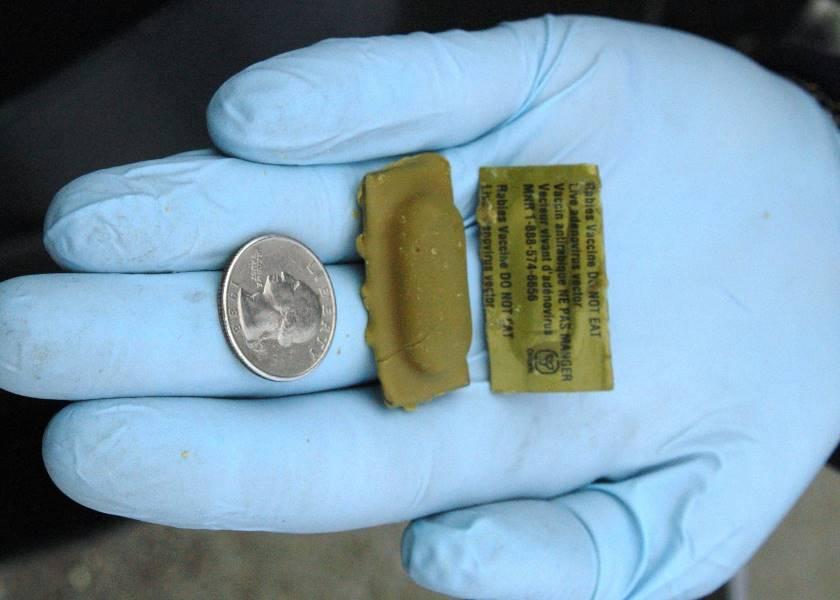Oral Rabies Vaccine for Raccoons, Skunks Continues Under Field Evaluation

USDA's Animal and Plant Health Inspection Service (APHIS) will continue field evaluation of the oral rabies vaccine (ORV) bait ONRAB in seven states.
The ONRAB bait is a blister pack filled with the vaccine and coated with a sweet attractant, APHIS said in a release.
"When an animal bites into one of the baits it will release the vaccine into their mouth and, with an adequate dose, develop immunity to rabies. Humans and pets cannot get rabies from contact with the bait but are asked to leave the bait undisturbed if they encounter it," APHIS said.
If contact with bait occurs, the contact area should be immediately rinsed with warm water and soap. Each bait carries a toll-free number that people can call if they have additional questions concerning a bait contact.
This year’s field evaluation is part of an ongoing project addressing operational questions related to bait density, distribution methods and effectiveness in raccoons, skunks, and other wildlife and is associated with a larger-scale rabies management effort in additional states, APHIS said in a release.
The National Rabies Management Program, led by APHIS’ Wildlife Services (WS), works to prevent the spread of rabies in wildlife. The program currently uses another rabies vaccine, RABORAL V-RG®, to control the disease in raccoons, coyotes and foxes. The ONRAB vaccine is being assessed to determine whether it can effectively manage rabies in raccoons and skunks.
Later this month, WS and cooperators will distribute 3.5 million ONRAB ORV baits in parts of Vermont, New Hampshire, New York, Ohio, Pennsylvania and West Virginia to test the immune effects in targeted wildlife. An additional small-scale project will take place during October in Chattanooga, Tenn., to evaluate the effectiveness of using ONRAB relative to bait distribution methods. Raccoons and skunks will be sampled by WS staff following bait distribution to determine vaccination rates.
This 2022 field evaluation of ONRAB is a collaborative effort among APHIS, the U.S. Department of Health and Human Services’ Centers for Disease Control and Prevention (CDC), the vaccine manufacturer (Artemis Technologies Inc., an indirect, wholly-owned subsidiary of Ceva Sante Animale S.A., Guelph, Ontario, Canada), and state departments of agriculture, health and natural resources.
Distribution of this ORV bait will span portions of:
• Allegany, Cattaraugus, Chautauqua, Clinton, Erie, Essex, Genesee, Jefferson, Lewis, Niagara, Oneida, Onondaga, Orleans, Oswego, St. Lawrence, and Wyoming counties in New York
• Addison, Caledonia, Chittenden, Essex, Franklin, Orange, Orleans and Washington counties in Vermont
• Coos and Grafton counties in New Hampshire
• Ashtabula, Belmont, Carroll, Columbiana, Geauga, Harrison, Jefferson, Lake, Mahoning, Monroe, Portage, and Trumbull counties in Ohio.
• Allegheny, Beaver, Crawford, Erie, Greene, Lawrence, Mercer, Washington, and Westmoreland counties in Pennsylvania.
• Barbour, Brooke, Doddridge, Greenbrier, Fayette, Hancock, Harrison, Lewis, Marion, Marshall, McDowell, Mercer, Monongalia, Nicholas, Ohio, Pocahontas, Raleigh, Randolph, Summers, Taylor, Tyler, Upshur, Webster, Wetzel, and Wyoming counties in West Virginia.
• Bradley, Hamilton, and Marion counties in Tennessee.
A Serious Public Health Concern
Rabies is almost always fatal once symptoms appear, but it also is 100% preventable. Human exposures can be successfully remedied if medical attention is sought immediately following exposure, APHIS said in a release. Costs associated with rabies detection, prevention and control may exceed $500 million annually in the U.S. According to the CDC, about 90% of reported rabies cases in the U.S. are in wildlife.
Click here for additional information concerning rabies or the ORV program.







